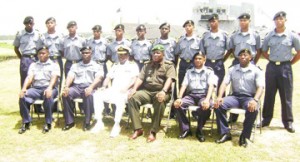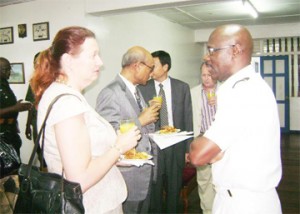For the first time in the history of the Guyana Defence Force Coast Guard, ten officers are undergoing local training at the induction stage.
At the end of the four-month training programme, which is funded by the Government of Guyana the officers are expected to competently perform duties as officers of the watch, craft commander on board any Coast Guard vessel and district commander of various Coast Guard locations.

The course was officially commissioned yesterday at the Coast Guard Head Quarters, Ruimveldt, Georgetown although it started in April.
Delivering the feature address, Chief of Staff, Commodore Gary Best alluded to the fact that in the past, the GDF trained its Coast Guard officers through scholarships offered by the government of the United Kingdom where the stage was set for a long-term engagement aimed at developing and strengthening the capacities of the force’s maritime unit. Shortly after, the Canadian Government lent support, organizing a series of “watch-keeping” courses for engineers and deck officers. The Brazilian and United States governments also had their parts to play. However, the scholarships were subsequently discontinued.
“Our partner nations who provided scholarships were no longer able to provide the quantum required to keep our officer base at the level required for good reason within their national security context… and so the Coast Guard found itself in severe difficulties,” Best said.
It was against this backdrop that the force decided that it must train its own Coast Guard officers. “We decided that we will accept what training is offered but we must develop our programme geared specifically for our needs.”

The GDF is open to further collaborative programmes with its partner nations, he said. It is envisaged that the programme can be further enhanced through professional exchanges between its staff and international partners.
For the next batch of training, Best said, the GDF intends to extend its arms to maritime partners in a move to forge its inter-agency maritime law enforcement course conducted by the Coast Guard.
Through the course it is expected that the national security architecture of Guyana would be further enhanced.
In his charge to the officers, Commodore Best said, “I charge you to be professionals and focus and that you use this training as a building block towards your contribution to the security of this nation.”
During the four-month training course students would be exposed to a number of areas of training including seamanship, fire fighting and damage control, international maritime law, navigation and pilotage, nautical rules of the road, radar, communication and maritime safety systems, oceanography and meteorology, boarding fundamentals, swimming and survival techniques and outboard boat handling. They are also required to undergo two weeks of on-the-job training and complete the underway and harbour officer of the watch qualifications aboard the GDFS Essequibo. They would have to complete two service papers, each with no less than 300 words about various issues relating to maritime/naval environment.
The course consists of six exercises which involve four motor life boat journeys to Linden, Bartica, and New Amsterdam and the North West District and two outboard journeys to New Amsterdam and Bartica. There would be four field trips.
Among those attending the commissioning ceremony were Minister of Public Works Robeson Benn, under whose ministry the maritime sector falls; High Commissioner of the United Kingdom, Fraser Wheeler; High Commissioner of Canada, Charles Court; Indian High Commissioner, Subit Kumar Mandal; Chinese Ambassador, Zhang Jungao; Military Attache from Brazil Colonel Antonio Dos Santos Filho and Charge d’Affaires of the US Embassy Karen Williams.





